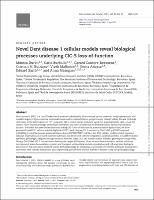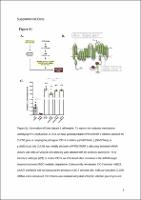| dc.contributor | Vall d'Hebron Barcelona Hospital Campus |
| dc.contributor.author | Durán Fernández, Mónica |
| dc.contributor.author | Cantero Recasens, Gerard |
| dc.contributor.author | Butnaru, Cristian M. |
| dc.contributor.author | Malhotra, Vivek |
| dc.contributor.author | Sarro Tauler, Eduard |
| dc.contributor.author | Meseguer Navarro, Anna |
| dc.contributor.author | Ariceta Iraola, Gema |
| dc.contributor.author | Burballa Tàrrega, Carla |
| dc.date.accessioned | 2022-06-17T10:38:15Z |
| dc.date.available | 2022-06-17T10:38:15Z |
| dc.date.issued | 2021-08-01 |
| dc.identifier.citation | Durán M, Burballa C, Cantero-Recasens G, Butnaru CM, Malhotra V, Ariceta G, et al. Novel Dent disease 1 cellular models reveal biological processes underlying ClC-5 loss-of-function. Human Molecular Genetics. 2021 Aug 1;30(15):1413–28. |
| dc.identifier.issn | 1460-2083 |
| dc.identifier.uri | https://hdl.handle.net/11351/7708 |
| dc.description | Enfermedad de Dent 1; Modelos celulares |
| dc.language.iso | eng |
| dc.publisher | Oxford University Press |
| dc.relation.ispartofseries | Human Molecular Genetics;30(15) |
| dc.rights | Attribution 4.0 International |
| dc.rights.uri | http://creativecommons.org/licenses/by/4.0/ |
| dc.source | Scientia |
| dc.subject | Ronyons - Malalties |
| dc.subject | Cromosoma X - Anomalies |
| dc.subject | Malalties congènites |
| dc.subject.mesh | Dent Disease |
| dc.subject.mesh | Mutation |
| dc.title | Novel Dent disease 1 cellular models reveal biological processes underlying ClC-5 loss-of-function |
| dc.type | info:eu-repo/semantics/article |
| dc.identifier.doi | 10.1093/hmg/ddab131 |
| dc.subject.decs | enfermedad de Dent |
| dc.subject.decs | mutación |
| dc.relation.publishversion | https://doi.org/10.1093/hmg/ddab131 |
| dc.type.version | info:eu-repo/semantics/publishedVersion |
| dc.audience | Professionals |
| dc.contributor.organismes | Institut Català de la Salut |
| dc.contributor.authoraffiliation | [Durán M, Cantero-Recasens G, Sarró E] CIBBIM Nanomedicina-Grup de Recerca en Fisiopatologia Renal, Vall d’Hebron Institut de Recerca (VHIR), Barcelona, Spain. [Burballa C] CIBBIM Nanomedicina-Grup de Recerca en Fisiopatologia Renal, Vall d’Hebron Institut de Recerca (VHIR), Barcelona, Spain. Centre for Genomic Regulation, The Barcelona Institute of Science and Technology, Barcelona, Spain. [Butnaru CM] Centre for Genomic Regulation, The Barcelona Institute of Science and Technology, Barcelona, Spain. [Malhotra V] Centre for Genomic Regulation, The Barcelona Institute of Science and Technology, Barcelona, Spain. Institució Catalana de Recerca i Estudis Avançats, Barcelona, Spain. [Ariceta G] CIBBIM Nanomedicina-Grup de Recerca en Fisiopatologia Renal, Vall d’Hebron Institut de Recerca (VHIR), Barcelona, Spain. Servei de Nefrologia Pediàtrica, Vall d’Hebron Hospital Universitari, Barcelona, Spain. Universitat Autònoma de Barcelona, Bellaterra, Spain. [Meseguer A] CIBBIM Nanomedicina-Grup de Recerca en Fisiopatologia Renal, Vall d’Hebron Institut de Recerca (VHIR), Barcelona, Spain. Departament de Bioquímica i Biologia Molecular, Unitat de Bioquímica de Medicina, Universitat Autònoma de Barcelona, Bellaterra, Spain. Red de Investigación Renal (REDINREN), Instituto de Salud Carlos III-FEDER, Madrid, Spain |
| dc.identifier.pmid | 33987651 |
| dc.identifier.wos | 000731099700004 |
| dc.rights.accessrights | info:eu-repo/semantics/openAccess |

 Área privada
Área privada Contacto
Contacto








